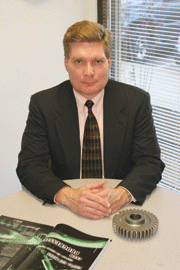E-Archive
MFN Trainer Column
in Vol. 8 - March Issue - Year 2007
What Is Laser Peening?

MFN Trainer David F. Lahrman
The readers of MFN are familiar with the benefits of shot peening to improve fatigue strength of metallic components. Laser peening is a process that also improves the fatigue strength of metal components by introducing surface compressive stresses. Instead of using beads to work the surface, laser peening uses light. The benefit of laser peening over shot peening is it improves the fatigue life of a part by a factor 1.5 times or more than shot peeing, but laser peening is not used for broad area coverage like shot peening. Laser peening is only used in critical areas on parts that have areas where extra fatigue strength is required.
When most individuals initially hear about the process, they think the energy of laser is being used to heat the part or even to melt the surface of the part. In reality, the part is not heated with this process. The microstructure remains essentially the same after processing. Laser peening uses a high-energy pulsed laser beam, to generate a shock wave on the surface of the part to cold work it at and near the surface.
So how does it work? The area to be treated is first covered with an opaque overlay that protects the surface of the part and provides a consistent medium for the energy of the laser beam to generate the plasma. The opaque overlay is usually a black tape or paint.
In the process, the opaque overlay is covered with a transparent overlay, usually water that confines the expanding plasma generated by the laser beam. The laser beam energy is delivered to the surface in a short pulse that is usually 20 nanoseconds in duration. The pressure in the expanding plasma will reach into the millions of MPa and generates a shock wave that propagates into the part. When the peak pressure in the shock wave is above the dynamic yield strength of the metal, it cold works the metal and produces a residual compressive stress. The compressive stresses can be as deep as 2.5 mm into the surface, but this is dependent upon the processing conditions and the metal being processed. A unique feature of laser peening is the cold working is spread over a larger volume than shot peening, which provides a benefit for higher temperature applications.
The first applications of this process were on the leading edges of turbine engine fan blades to mitigate the detrimental effects of foreign object damage. The US Air Force was the first to benefit from the application of this process on their aircraft. It saved them from having to conduct expensive daily engine inspections on their aircraft and increased their mission readiness.
MFN is introducing laser peening at its 10th International MFN Shot Peening Workshop & Trade Show in Florida on March 15th to 17th, 2007. You will have an opportunity to learn more about the process first hand and to ask questions to better understand the process. Plan on attending these well managed workshops to learn more about laser peening and other related topics.
More information about this event can be found at www.mfn.li/workshops.
Best Regards
David F. Lahrman
david@mfn.li
Author: David F. Lahrman




























